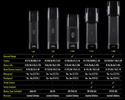
How Long Should an LED Last?
, by Chas Waters, 3 min reading time

, by Chas Waters, 3 min reading time
With modern improvements and a culture defined by taking steps toward a greener, brighter tomorrow, more companies are producing LED bulbs and products to replace traditional incandescent lights. Along with its eco-friendly, non-toxic design and energy efficiency, LEDs are also appealing because of the bulb’s superior lifespan compared to incandescent and fluorescent alternatives.
When you flip the package of an LED lightbulb to check out its performance benefits, you’ll likely see an impressive message from the manufacturer claiming the LED has a lifespan of 50,000 hours or longer. Have you ever tried to picture 50,000 hours in a tangible timeframe — tens of thousands of usable hours is nearly incomprehensible, so are LED brands being overly optimistic or is this lifespan realistic?
By understanding how LEDs work compared to traditional incandescent bulbs, you can be a better and savvier consumer.
It’s important to know how lightbulbs work to understand how manufacturers determine the lifespan of an LED light. Incandescent bulbs use a tungsten filament to produce light. While in use, electric currents flow through the filament, creating heat and light. This filament gradually becomes thinner as heat gets applied. The end of the light bulbs’ lifespan is marked when this filament fails. This is caused by the filament becoming so thin that it eventually breaks, unable to complete the electric current and produce light.
LEDs — light-emitting diodes — do not use a filament to produce light. Instead, a semiconductor light source emits light when a current gets introduced. With an LED, the light output simply diminishes with use over time.
The manufacturer estimates the lifespan of an LED bulb based on estimated daily lighting usage. While this seems like a practical method, companies are using a modest figure — only three or four hours of use per day — to reach an impressive 50,000 hour lifespan or approximately 35 years.
If you’re often away from home or if the bulb is installed in a light fixture you seldom use, the 50,000-hour, 35-year figure is likely accurate. In contrast, if you had your lights turned on for 24 hours a day, the lifespan of an LED would only be about six years.
Most homes likely strike an even balance between turning fixtures on all hours of the day and only three hours at night, making the most accurate lifespan of an LED lightbulb approximately eight to 10 years.
When you need exceptional lighting solutions to effortlessly face your most challenging day-to-day activities, check out the wide selection of revolutionary LED lighting solutions available at Panther Vision. We offer a variety of LED apparel and devices, including our POWERCAP® LED lighted hats, LIGHTSPECS® safety and reading glasses and FLATEYE™ hand-held devices.
All of our LED products are crafted from the finest recycled materials for extended, comfortable performance with ultra-powerful LED bulbs producing impressive, long-lasting output. Check out our selection of LED products and apparel today and see the different LEDs can make in your life.